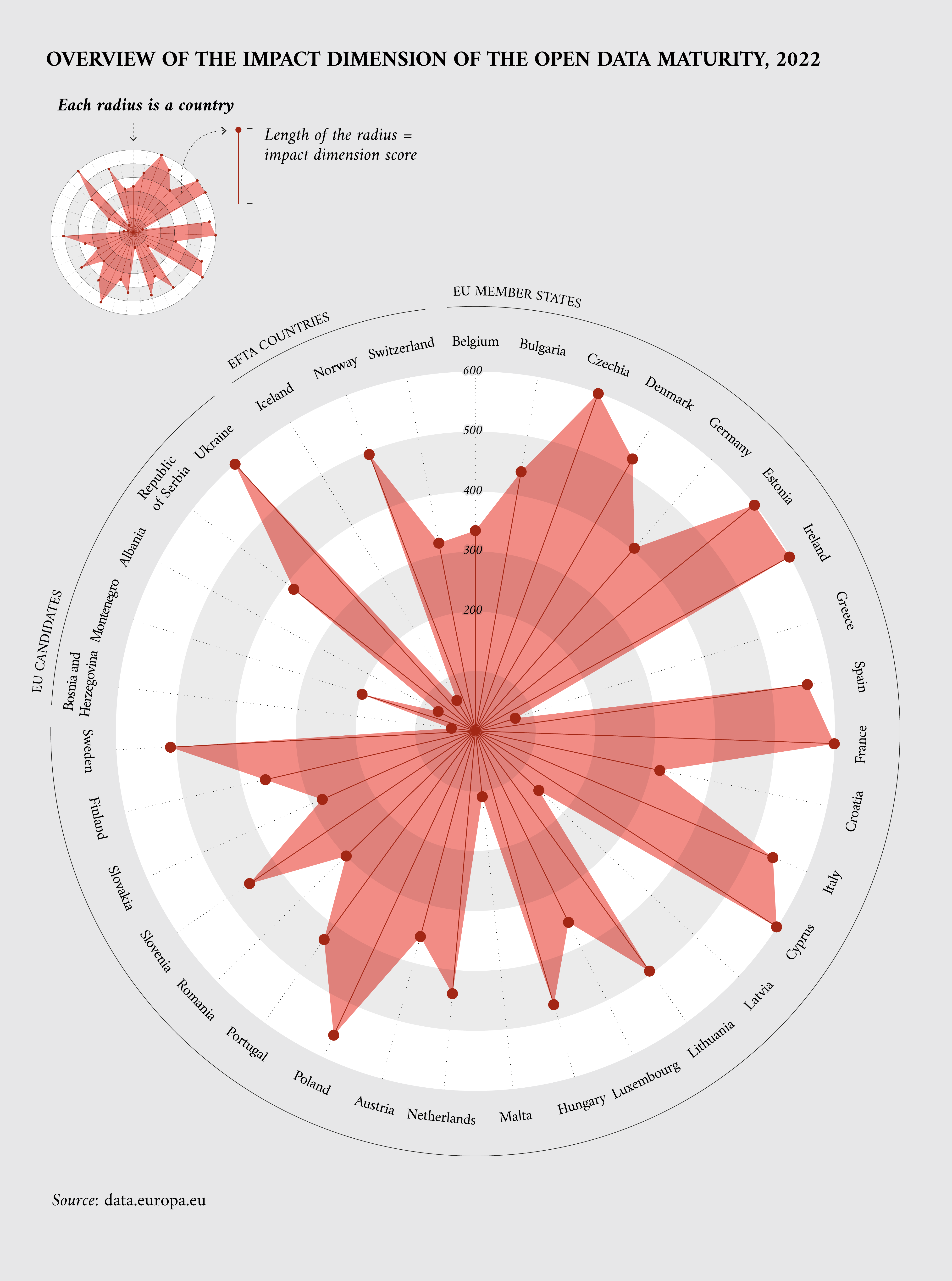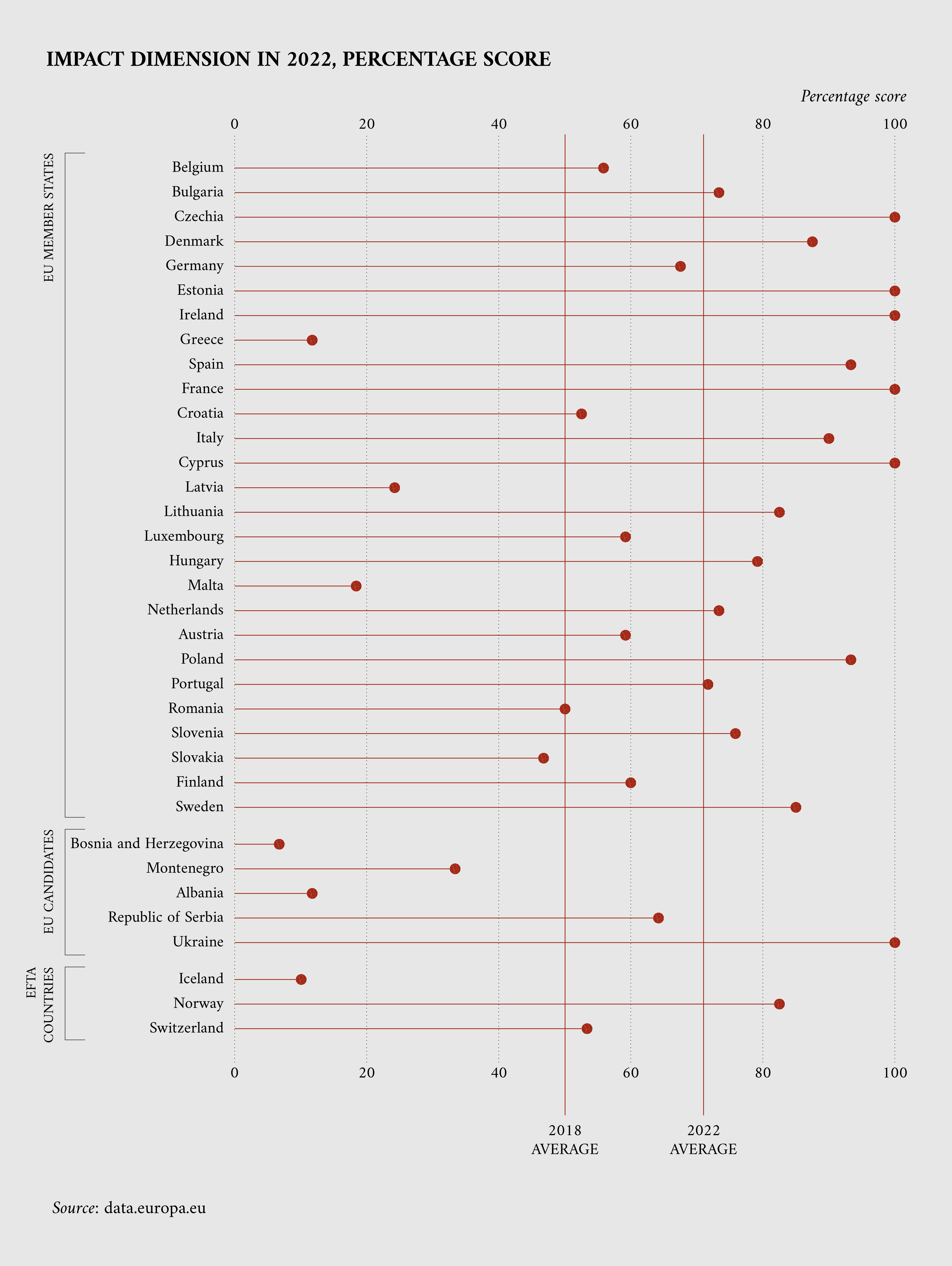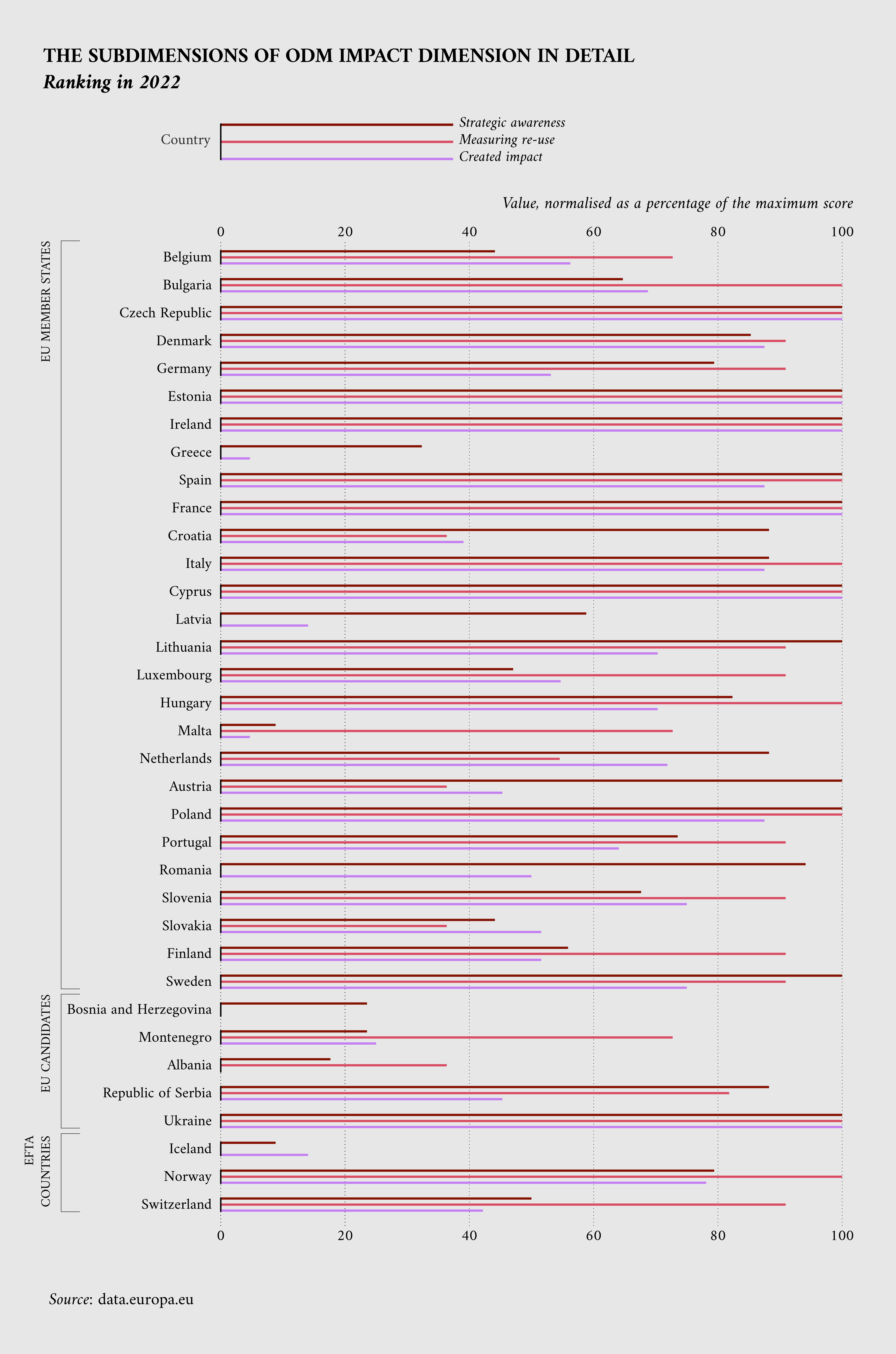Open Data Maturity Report 2022: Countries’ perspectives on their open data impact
Inspiring potential reusers and following up with them helps to understand the impact of open data reuse
The report on open data maturity (ODM) provides an overview of the progress achieved by European countries as they push forward to unlock the value of open data. The concept of ODM in Europe is considered against four dimensions: quality, portal, policy and impact.
This data story explores the impact dimension and is the fifth in a series on the 2022 ODM report. The first data story announced the report’s publication and presented the overall results. The second data story discussed the quality dimension of the methodology, the third data story covered the portal dimension, and the fourth data story explored the policy dimension.
There is no universal definition of open data impact, particularly since open data can have an impact on diverse domains. This lack of a universal definition sometimes makes it difficult for countries to give evidence of the socioeconomic impact of open data. Nonetheless, the data.europa.eu research team has put effort into harmonising its their definition of open data impact and researching this topic further. For example, its 2020 report on the economic value of open data investigated the value created by open data in Europe. The report estimated that the open data market size in 2020 was EUR 184 billion and forecasted the market to reach between EUR 199.51 and EUR 334.21 billion in 2025.
Despite the difficulty of finding a general definition, a consistent element of impact is reusing open data for a beneficial purpose. The impact can be analysed from economic, governmental, social and environmental perspectives to demonstrate the value that reusing data can bring to society. One example of such a method is the use case observatory that is monitoring 30 reuse cases over 3 years to gain a longitudinal understanding of the holistic impact created by exemplar open data reuse cases. The ODM assessment also provides a periodic (on an annual basis) measurement of open data impact through the impact dimension of the methodology.
This data story features the perspectives of Hungary, the Netherlands and Sweden (see Figure 1 for country scores). These three countries share their experiences and knowledge to inspire others in the open data community to improve on the impact dimension. The story first provides an overview of the impact dimension. Then it presents the successes and improvement points of the three featured countries, analysing their common themes and differences. Lastly, it explores the specific indicators of ‘strategic awareness’, ‘measuring reuse’ and ‘created impact’ in more detail to highlight best practices.

Figure 1: Overview of the ODM impact dimension 2022 country scores
The impact dimension in a nutshell
Open data holds great potential value, and this value is unlocked when the data is reused. The impact dimension of ODM assesses the activities undertaken to monitor and measure open data reuse and the impact created through this reuse. The dimension focuses on the extent of implementation of impact mechanisms, the tools in place to understand how open data is reused and real use cases in different areas. Earlier editions of ODM measured impact primarily through efforts to measure reuse. The ODM methodology was revised in 2022 to better distinguish between measuring the reuse of open data and the impact created through this reuse (see the ODM method paper for an elaborated discussion about the method revision).
The revised impact dimension now assesses several criteria grouped into three indicators .
- Strategic awareness. The extent to which mechanisms are in place to foster and monitor open data reuse.
- Measuring reuse. The extent to which tools are in place to understand which and how datasets are reused.
- Created impact. The extent to which examples of reuse cases exist to showcase the impact of open data in several areas (political, social, environmental and economic).
Countries are scored based on a list of questions relating to each indicator, which, when summed together, provide a total score for the dimension. The impact dimension is the least mature dimension of the ODM, having the lowest average score (71 %) among the four dimensions evaluated in the ODM for the EU-27 (the other dimensions have an average score between 77 % and 86 %). One reason for the impact dimension scoring the lowest is that open data reuse is partly the outcome of the other dimensions. In other words, a good open data policy, a good portal, and good metadata quality encourage reuse. Of course, focused efforts are needed to stimulate reuse, but maturity of the other dimensions support this. In addition, the impact dimension underwent a major restructuring in terms of method. The restructuring introduced additional measurements in the form of a new indicator, measuring reuse. These additional requirements lowered the average score on this dimension compared to previous years. Nonetheless, the average score for the EU-27 has increased significantly from the first ODM in 2018 (50 %) to the 2022 ODM (71 %) (Figure 2).

Figure 2: ODM portal scores in 2022 for all 35 participating countries showing the 2018 and 2022 averages
A common strategy for success: Creating awareness of open data and following up with reusers
The three featured countries, Hungary, the Netherlands and Sweden, all have their own processes to measure the impact of open data. However, two commonalities stand out. Firstly, the national portal is an important tool to create awareness and gather examples of reuse cases. Secondly, creating a strong community of reusers is an amplifying force to spread awareness of open data and a way to learn how and what reusers are creating with open data.
The Hungarian open data team attribute the country’s performance on the impact dimension to their proactive efforts in promoting greater cooperation among various stakeholders and making use of data analytics to understand users’ perceptions. The team have put effort into collecting and analysing a significantly large volume of data and information from the national portal regarding the impact of open data across multiple sectors. In addition, Hungary has a new national open data portal that was launched in December 2022. Having a portal should aid the promotion of public data reuse, therefore contributing to an elevated understanding of the impact and potential of open data among stakeholders in different sectors.
To continue to improve, the Hungarian team intend to further promote the national portal, increasing awareness among stakeholders and broader segments of society. At the same time, they plan to enhance their method and systems for tracking the impact of open data.
The Swedish open data team also attribute some of their impact dimension success to their national portal, which is used as a platform to build a community around open data. The Swedish national data strategy (2021) resulted in an assignment for the Agency of Digital Government to strengthen the public sector data-sharing capabilities through the portal on both the strategic level and the operational level . The process towards the new national open data law (2022) also created public awareness, which fuelled a growing interest in data sharing.
Nonetheless, the Swedish team have the ambition to improve communication with both data providers and data consumers to better understand what to do and why. A priority for the team is to improve the process for gathering open data reuse cases and to show them on the national portal in an inspiring way. The team also consider it important to improve the feedback to politicians about the progress of open data reuse and the related impacts to gain support for data sharing and data use initiatives. Since reuse and impact require access to data, part of the effort to improve on the impact dimension is also aimed at making more data accessible for reuse.
The Dutch open data team try to gain a holistic view of the impact of open data by conducting interviews with reusers. The team recognise that it is difficult to measure the impact that published data has, because open data can be reused in so many different fields, all of which will have different significance for the impact. The benefits they identify with the interview approach is that they do not have to define what impact is nor do they have to be experts in every field of reuse.
To improve going forward, the team recognise that they must achieve a balance between conducting interviews with reusers and documenting activities and describing deliverables. In other words, the team must find the best mixture of complementary methods to measure impact.
The impact dimension in detail
In addition to their self-reflections on their overall performance on the impact dimension, the three featured countries also share their best practices for the three indicators that make up the impact dimension. Figure 3 provides a detailed overview of the countries’ scores per impact indicator in 2022.

Figure 3: ODM ranking on the three indicators of the impact dimension in 2022 for all 35 participating countries
1. Strategic awareness
The strategic awareness indicator targets the extent to which countries define reuse and are prepared to measure it. The indicator also aims to understand how countries define open data impact and have methodologies in place to assess it. In other words, this indicator covers the effort and resources that countries put into understanding the impact of open data through monitoring mechanisms.
The open data team in Hungary reflect that the legal framework (Act No LXIII of 2012 and Act No XCI of 2021) that governs the reuse of public data in their country provides the impetus for strategic engagement with stakeholders. This legislative foundation has enabled a renewed push to promote strategic awareness across institutions in the process of impact assessment and planning. Specifically, this legislative foundation enabled the establishment of the National Data Asset Management Agency, the remit of which includes data reuse.
In Sweden, the open data team launched a community platform on the national portal in 2021 for users to share their experiences, knowledge and needs. This action has enabled strategic awareness about open data to be ‘crowd-driven’, with the community contributing to awareness at their respective workplaces and in various projects. Another initiative by the Swedish Agency of Digital Government is a train-the-trainer style data ambassador programme that educates public sector employees to be educators on the topic of open data themselves. This programme has created a network effect and a broad interest in open data across various public organisations. A strong and engaging community helps the open data team monitor the impact of open data.
In the Netherlands, the open data team say they recognise that the data landscape in their country is evolving. Consequently, they keep asking themselves what they want to know about impact and how they can get this information. Such questions enable the team to develop their methods of measuring impact with the evolving data landscape.
2. Measuring reuse
The measuring reuse indicator evaluates the actions taken by countries to measure reuse, including an overview of systematic ways of gathering and classifying reuse cases. This indicator also investigates the methods used by countries to identify datasets that have been reused. Furthermore, it focuses on activities undertaken to better understand the needs of reusers.
The Hungarian national open data portal and its integration with analytical tools help the open data team quantify reuse cases. These analytics are complemented by stakeholder engagement to understand the impact of reuse cases more deeply. Within the government, the Data Asset Management Agency has an overall view of datasets regarding their legal, policy and technical background, and contributes to data-driven decision-making and reuse of data.
Similarly, the Swedish open data team use web statistics from the national portal to get a sense of overall progress on reuse. This overview is complemented by insights from the community. In addition, Sweden has identified different types of reuse during the work done to create the national guidelines for data sharing. Their open data team aim to use these guidelines to classify and monitor reuse cases.
Although the Dutch open data team also monitor the reuse of datasets on the portal, the focus of their approach is to conduct interviews with reusers and publish these as impact stories. The team gather stories by following up with reusers who request datasets through the national portal, and through events or requests to be interviewed submitted by reusers.
3. Created impact
The created impact indicator evaluates the benefits generated by open data and its reuse on government, society, the environment and the economy. For each of these impact areas, the indicator gathers existing data summarising the impact created by open data and specific reuse case examples that illustrate open data reuse.
The Hungarian open data team reflect that the process of gathering insights from stakeholders across different sectors has enriched their understanding of the varying impact brought about by open data. The team can then use this understanding to review their activities in line with the needs of reusers. For example, portal users showed a strong interest in data about recycling. The team therefore collected more insights and produced specific visualisations and analysis to promote the value of open data.
The Swedish open data team also note the broad variety of open data impacts in their country from both private citizens and the public sector. In Sweden, there is high usage of geodata and transport data, with several new digital services created for different types of transport. For the team, a flagship reuse case is an application resembling the Pokémon Go game. The application uses open data from the Swedish Species Information Centre and enables users to identify plants and species in nature. Additionally, the application encourages users to collect data that is then fed back to the inventory database, creating an interesting double impact through citizen-generated data.
The Dutch open data team echo this view, noting that in many cases reusers are proud of their usage of open data. Correctly processing data or creating an application takes a lot of effort, and if a podium is provided for their effort, they gladly take it. However, the team do acknowledge the effort also required from their side to find good impact stories and conduct interviews. But as awareness of their impact stories grows, more people reach out to the team with their reuse cases.
Conclusion
Open data can be used to create an impact on society. Overall, Europe has shown strong development in the impact dimension of ODM since 2018. Nonetheless, there is still a gap in maturity between the impact dimension and the other three dimensions of ODM. The experiences and insights provided by Hungary, Sweden and the Netherlands can be a source of new ideas and practices for other countries to continue encouraging and monitoring the impact open data is creating.
For the featured countries this means leveraging their national portal to have two-way communication with reusers. On the one hand, the portal makes users aware of the potential reuses of open data. On the other hand, reusers use the portal to showcase the impact of their creations. Moreover, supporting activities that engage the community creates a virtuous circle where more awareness of the value of open data leads to more reusers who are proud to share their innovative reuse cases, and in turn, there is more awareness of the value of open data.
Interested in learning more about open data maturity? Read the ODM report for more insights into the 2022 assessment, view our interactive ODM dashboard, and explore the related courses on the data.europa academy. Keep up to date by subscribing to our newsletter and following data.europa.eu on social media.
Many thanks to Adél Krasznai (Hungary), Ulrika Domellöf Mattsson (Sweden), Casper Gras (Netherlands) and Jasper Kars (Netherlands) for their contributions to this data story on behalf of their national open data teams. Figures created by Frederica Fragapane.
